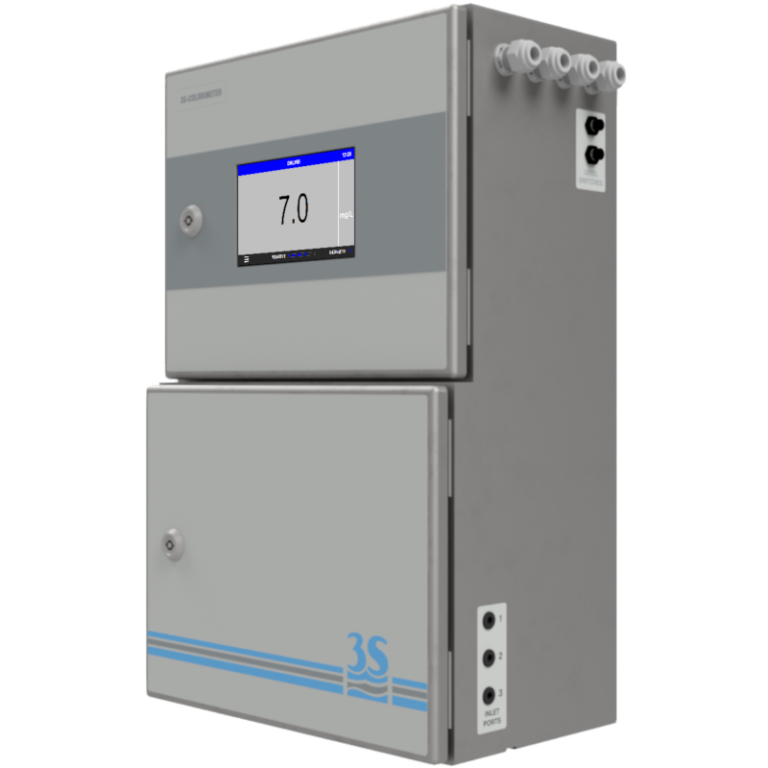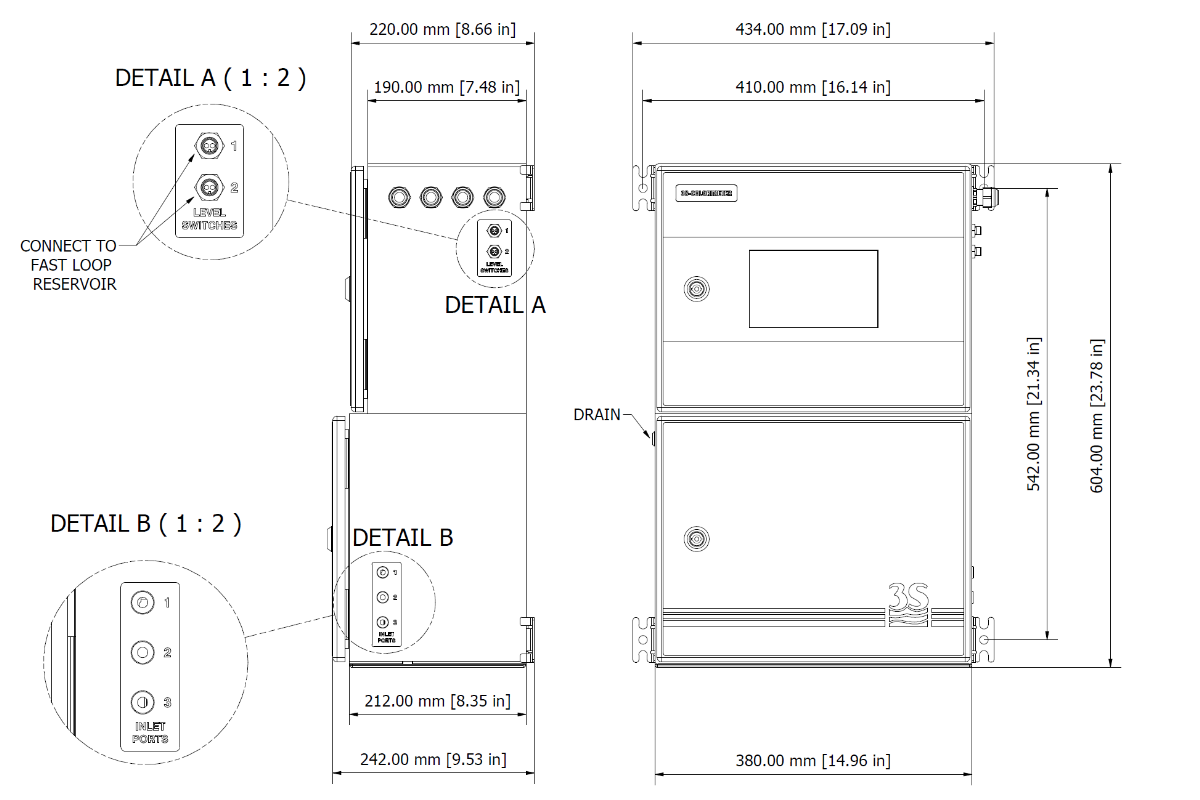Applications
- Waste water treatment plants
- Industrial applications
- Surface water monitoring
- Process control

Description
The 3S colorimeter is a compact analytical instrumentation for online analysis and process monitoring. The colorimeter is based on a color-developing chemical reaction carried out inside the analyzer's glass cell. The sample, coming from an external reservoir or process stream is autonomously grabbed by the instrument and mixed with the appropriate reagents to make the reaction happen. The analyzer uses an LED light source and a photodiode to photometrically measure the developed color intensity (absorbance). The absorbance is proportional to the concentration of the target chemical species (analite).
Features:
- Low reagents consumption and analytical reliability thanks to our custom designed miniature peristaltic pumps
- Dual compartment design to guarantee a complete separation between the electronics and the hydraulic section
- Color touchscreen to show the last measured value clearly, and to set all the options and settings via an user friendly interface
- Datalogger function with data history in graphical form and USB download
- Automatic calibration, validation and cleaning to reduce down time and operator intervention, their frequency can be freely set by the user
- Fully integrable in industrial automation via the analog outputs (2 x 4-20 mA channels), digital output (2 relays + ModbusRTU) and digital input (voltage free contact)
Phosphorus occurs in several forms: ortho, poly and organically bound. Further classification can be made on whether the phosphorus is dissolved (passing through a 0.45 micron filter). In TP oxidation / digestion, polyphosphates and organic phosphorus are converted into orthophosphate. Organic phosphorus is converted to orthophosphate by UV catalyzed persulfate digestion; polyphosphates are converted to orthophosphate by sulphuric acid digestion. All forms of phosphorus are converted to its ortho form in the TP procedure, in the presence of persulfate and an acid background.
The Total Phosphorus concentration can be measured using two different methods depending on the range requested.
Both methods use advanced photochemical oxidation, sulphuric acid, heat, UV irradiation and a chemical oxidizer (sodium persulfate). After the complete oxidation of the phosphorus in the sample to PO4, then a colorimetric reaction is performed and the intensity of the colour developed is proportional to the phosphate concentration present in the sample.
The determination ranges of the TP analyzer vary from trace ppb to 400 mg/L TP, using the (optional) external dilution module.
Method
The sample is previously digested with acid and completely oxidated with UV/persulfate. Then the blue fostate method is applied. Molybdate reacts in acid medium with orthophosphate to form phosphomolybdic acid, which is then reduced to intensely colored molybdenum blue. The absorbance intensity is proportional to the phosphate concentration in the sample and is determined at 850 nm.
Features
| Measured parameter | PO43- | ||||||
|
Range
|
|||||||
|
Reproducibility*
|
|||||||
| Wavelength | 850 nm |
| Demineralized water | Not required |
| Number of reagents | 2 |
| Min. analysis time | 8 minutes |
Reagents and standards
The sample is previously digested with acid and completely oxidated with UV/persulfate. Then the yellow fostate method is applied. The reagent, containing sodium molybdate and ammonium meta-vanadate in an acid medium, reacts with the orthophosphate to form a yellow coloured phospho-vanado-molybdate compound. The absorbance intensity is proportional to the phosphate concentration in the sample and is determined at 430 nm.
Features
| Measured parameter | PO43- | ||||||
|
Range
|
|||||||
|
Reproducibility*
|
|||||||
| Wavelength | 430 nm |
| Demineralized water | Not required |
| Number of reagents | 1 |
| Min. analysis time | 8 minutes |
Reagents and standards
Technical Specifications
| Model | 3S-CL |
| Sampling Mode | Batch, with freely settable frequency. |
| Sample | Pressure: Atmospheric Temperature: 5 ‐ 45°C (41 ‐ 113°F) Flow Rate: 80 to 500 mL/min Connection: 6 mm (¼-in.) |
| Drain |
Pressure-free drain Connection: 12 mm (½-in.) |
| Input Streams | 2 |
| Material | Epoxy-coated stainless steel AISI 304 |
| Dimensions (H x W x D) | 604 x 380 x 210 mm (23.6 x 14.8 x 8.2 in) |
| Weight | 20 kg (44 lbs) |
| Power Supply |
Input Voltage: 115 VAC,230 VAC Power consumption: max. 80 W |
| Output signals |
2 x 4-20 mA analog outputs Modbus via RS485,Ethernet |
| Alarms | 2 SPDT programmable voltage-free relays |
| Digital Input | None, Online, Start Extra, Skip Idle, Emergency Stop |
| Ambient Temperature | 5 - 45 °C (41 - 113 °F) |
| Ambient Humidity | 10 - 90 % RH (non-condensing) |
| Protection Grade | IP54 (indoor only, outdoor use possible with external cabinet, not included) |
